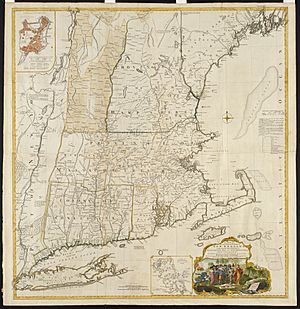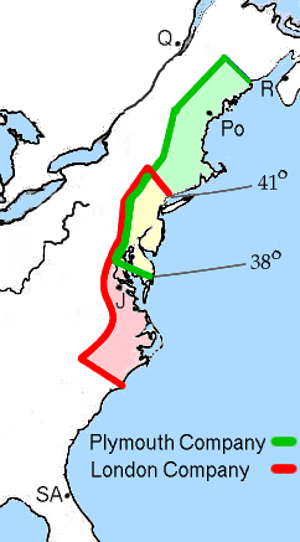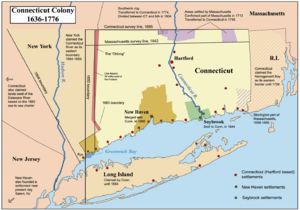New England Colonies facts for kids
Quick facts for kids
New England Colonies
|
|
|---|---|

Map of New England Colonies in 1755
|
|
| Composition | |
The New England Colonies were a group of British settlements in North America. They included Connecticut Colony, the Colony of Rhode Island and Providence Plantations, Massachusetts Bay Colony, Plymouth Colony, and the Province of New Hampshire. These colonies were part of the original Thirteen Colonies that later formed the United States.
Eventually, Plymouth Colony joined with Massachusetts. Maine also became a separate state later. The term "New England" was first used in 1616 by Captain John Smith for the coastal lands from Long Island Sound to Newfoundland.
Contents
First Arrivals in America
In the early 1600s, England, France, and the Netherlands all tried to set up colonies in New England. These countries often fought over land in the New World. In 1604, a French nobleman named Pierre Dugua Sieur de Monts started a settlement on Saint Croix Island, Maine.
However, almost half of the settlers died during the harsh winter from cold and scurvy. In the spring of 1605, the survivors moved north to Port-Royal in Nova Scotia.
King James I of England saw the need for a lasting English settlement. He gave land grants to two different groups: the Plymouth Company and the London Company. In August 1607, ships from the Plymouth Company arrived at the Kennebec River.
They built a settlement called Sagadahoc Colony, also known as Popham Colony. The colonists faced a very cold winter and lost supplies in a fire. They also had mixed relationships with the local Native tribes.
The colony's leader, Captain George Popham, died. Another leader, Raleigh Gilbert, decided to go back to England. Because of this, all the colonists chose to return to England in August 1608. They left on a ship called Mary and John and a new ship they built themselves.
This new ship was named Virginia of Sagadahoc. It was 30 tons and was the first ocean-going ship ever built in North America.
Fighting over land continued. In 1613, the French built Fort Pentagouet in Maine. This fort protected a trading post and a fishing spot. It was the first long-term settlement in New England. Over the years, the English, French, and Dutch colonists took turns controlling it.
In 1614, Dutch explorer Adriaen Block explored the coast of Long Island Sound. He traveled up the Connecticut River to where Hartford, Connecticut is today. By 1623, the Dutch West India Company regularly traded for furs there. They later built a fort for protection from the Pequot Indians. They called it "House of Hope" or "Fort Hoop".
Building the New England Colonies
A group of Puritans, known as the Pilgrims, arrived on the ship Mayflower. They came from England and the Netherlands to start Plymouth Colony in Massachusetts. This was the second successful English colony in North America, after Jamestown, Virginia.
About half of the more than one hundred passengers on the Mayflower died that first winter. Many got sick during the voyage, and the winter was very harsh. In 1621, a Native American named Squanto taught the colonists how to grow corn. He also showed them where to catch eels and fish. His help was very important for their survival in the early years. The Pilgrims settled on the same land where Squanto's Patuxet tribe had lived before they were wiped out by diseases.
The Plymouth settlement faced many difficulties and did not make much money. However, it had a good reputation in England. This encouraged more people to move to America. Edward Winslow and William Bradford wrote a book about their experiences called Mourt's Relation (1622). This book showed some of the challenges the Pilgrims faced. It encouraged other Puritans to come during the Great Migration between 1620 and 1640.
The Puritans in England first sent smaller groups in the mid-1620s. They wanted to set up colonies, buildings, and food supplies. They learned from the Pilgrims' hard winter experiences in Plymouth. In 1623, the Council for New England (which took over from the Plymouth Company) started a small fishing village at Cape Ann. This was overseen by the Dorchester Company.
The first group of Puritans moved to a new town nearby called Naumkeag after the Dorchester Company stopped its support. New financial help was found by Rev. John White. Other small settlements began in nearby areas. However, the total Puritan population stayed small through the 1620s.
A larger group of Puritans arrived in 1630. They left England because they wanted to worship God in a different way than the Church of England. Their beliefs were similar to the Pilgrims who came on the Mayflower. However, the Mayflower Pilgrims felt they needed to completely separate from the Church of England. The later Puritans were happy to stay connected to the Church. These separate colonies were governed independently until 1691. That's when Plymouth Colony joined with the Massachusetts Bay Colony to form the Province of Massachusetts Bay.
Spreading Out
The Puritans also started the first public school system in America. Their main goal was to make sure future generations could read the Bible for themselves. This was a very important part of Puritan worship. However, people who disagreed with the Puritan laws were often sent away from the Massachusetts Bay Colony. John Wheelwright left with his followers to start a colony in New Hampshire. He then moved on to Maine.
In January 1636, during the middle of winter, Roger Williams was banished from the Massachusetts Bay Colony. This was because of his different religious ideas. One of his main beliefs was that government and religion should be separate. He also thought that the colonies should buy land fairly from the Wampanoag and Narragansett tribes.
Officials in Massachusetts wanted to send him back to England by force. But he escaped and walked through deep snow from Salem, Massachusetts to Raynham, Massachusetts, which is 55 miles away. Native American tribes helped him survive. They also sold him land for a new colony. He named it Providence Plantations. He chose this name to show that God had helped him start the new colony. It was special because it offered religious freedom and kept church and state separate. Other people who disagreed with the Puritans started two more settlements on Rhode Island (now called Aquidneck Island) and another in Warwick. These four settlements eventually joined to form the Colony of Rhode Island and Providence Plantations.
Thomas Hooker left Massachusetts in 1636 with 100 followers. He founded a settlement just north of the Dutch Fort Hoop. This settlement grew into Connecticut Colony. The community was first called Newtown, then renamed Hartford to honor an English town. One reason Hooker left Massachusetts Bay was that only church members could vote. He believed any adult male who owned property should be able to vote and take part in government.
He received a royal charter and created the Fundamental Orders of Connecticut. These are considered one of the first constitutions in America. Other colonies later joined the Connecticut Colony under its royal charter. These included New Haven and Saybrook Colony.
Trade and Economy
The first colonies in New England were usually fishing villages or farming communities. They were built on the more fertile land along the rivers. The soil in the New England Colonies was rocky and not as rich as in the Middle or Southern Colonies. However, the land had other valuable resources.
Lumber was very important. It was used for building and was also sent back to England, where wood was scarce. Hunting animals provided furs for trade and food for the colonists.
The New England Colonies were located along the Atlantic coast. This area had lots of sea life. Excellent harbors and some inland waterways protected ships. They were also good for fresh water fishing. By the end of the 1600s, New England colonists had built a trade network across the Atlantic. This connected them to England, the Slave Coast of West Africa, plantations in the West Indies, and the Iberian Peninsula. Colonists bought British and European goods like glass, linens, tools, and other household items.
The Southern Colonies could produce tobacco, rice, and indigo to trade for imports. New England's colonies mainly offered fish, furs, and lumber to England. Making their own money was sometimes an issue. During the 1700s, shipbuilding became very important. It used the plentiful lumber and helped the economy grow.
The Hull Mint in Massachusetts made its own silver coins for over 30 years. These coins included the pine tree shilling.
Native American Enslavement in New England
During conflicts between European settlers and Native Americans in New England, like the Pequot War (1636-1638) and King Philip's War (1675-1678), captured Native Americans were sometimes forced into labor or sold. Using captured prisoners of war for forced labor was common in Europe at the time.
Plymouth Colony ranger Benjamin Church spoke against the practice of enslaving Native Americans in 1675. He called it "an action so hateful." However, Church did own enslaved Africans, like many other colonists. During King Philip's War, captured Native Americans were sent on New England merchant ships to the West Indies. There, they were sold to European plantation owners.
Colonial rules often stated that "no male captive above the age of fourteen years should reside in the colony." It is thought that at least a thousand Native Americans from New England were sold into slavery during King Philip's War. More than half of these came from Plymouth.
Education in the Colonies
In the New England Colonies, the first settlers, the Pilgrims, and later Puritans believed in education. They taught their children how to read and write. This was so the children could read and study the Bible for themselves.
Depending on a family's social standing and wealth, children were educated in different ways. Some were home-schooled by their parents. Others attended public grammar schools or had private teachers called governesses. Subjects included reading, writing, Latin, Greek, and more.




